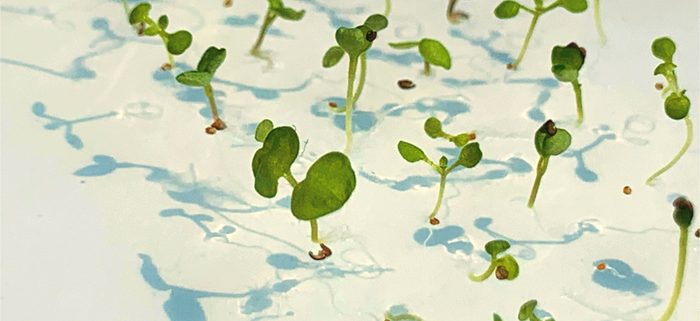How plants tolerate too-close vegetation – plants get tolerant to other plants
Molina-Contreras et al. show how differences in photoreceptors produce the differing shade responses of Arabidopsis and Cardamine.
https://doi.org/10.1105/tpc.19.00275
by Sandi PAULIŠIĆ 1 and Jaime F. MARTINEZ-GARCIA 1,2
1, Centre for Research in Agricultural Genomics (CRAG) CSIC-IRTA-UAB-UB.
2, Institució Catalana de Recerca i Estudis Avançats (ICREA).
Background: Plant development is strongly influenced by the proximity of other plants, as neighboring vegetation might shade and reduce light availability. Not enough light may compromise photosynthesis and hence plant growth. The so-called shade-avoiding species respond to vegetation proximity by trying to escape it. These responses include increased elongation (to overgrow neighboring competitors for light), reduced levels of photosynthetic pigments (to adjust photosynthesis to the available light) or flowering induction (to ensure a next generation). This is the case in Arabidopsis thaliana, in which exposure to plant shade leads to shade-avoidance responses. Those plants growing in forest understories or next to other plants tolerate and do not elongate in response to neighboring vegetation. One of these species is Cardamine hirsuta, whose hypocotyls are unresponsive to plant shade.
Question: We wondered how the elongation response is oppositely regulated in these plants. As these two species are closely related, we aimed to know if C. hirsuta uses the same or different components to regulate its hypocotyl elongation response to plant shade as A. thaliana.
Findings: Using a genetic approach, we identified C. hirsuta mutants with a restored ability to elongate hypocotyls in response to plant shade. We named these mutants slender in shade 1 (sis1), which were deficient in the photoreceptor phytochrome A (phyA). Because phyA was already known to inhibit the shade-induced elongation of Arabidopsis seedlings, our results indicate that shade avoidance and tolerance in these plants have shared components to regulate this divergent response. In addition, phyA is more active in Cardamine than Arabidopsis, which results from a higher expression and a stronger intrinsic activity of this photoreceptor in Cardamine compared to Arabidopsis.
Next steps: Our knowledge can help attenuate plant responses to shade. As most crops are shade-avoiding species, this knowledge can result in shade-tolerant crop varieties that grow well at high planting density, maximizing land use. It can also lead to engineering shade-avoiding beneficial weeds (that provide refuge to beneficial animals or enhance soil quality) to thrive in shaded or semi-shaded areas to be used in conservation agriculture approaches.
Maria Jose Molina-Contreras, Sandi Paulišić, Christiane Then, Jordi Moreno-Romero, Pedro Pastor-Andreu, Luca Morelli, Irma Roig-Villanova, Huw Jenkins, Asis Hallab, Xiangchao Gan, Aurelio Gomez-Cadenas, Miltos Tsiantis, Manuel Rodríguez-Concepción, Jaime F. Martínez-García (2019) Photoreceptor Activity Contributes to Contrasting Responses to Shade in Cardamine and Arabidopsis Seedlings




